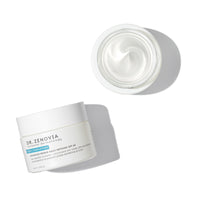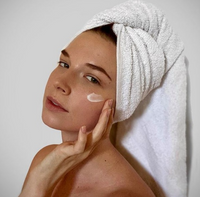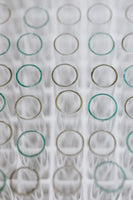What Happens to Your Skin After a Hysterectomy?

A common surgery among women, a hysterectomy is a surgical procedure that removes the uterus. Partial hysterectomies leave the cervix intact while total ones involve the removal of the cervix, ovaries, and fallopian tubes. In addition to the deeply emotional side effects, skin changes are a common physical side effect post-hysterectomy.
Skin Changes After a Hysterectomy
Post-hysterectomy, some women report increased oiliness and breakouts while others experience skin dryness. The type of hysterectomy one’s undergone and whether they are using hormone replacement therapy (HRT) plays a major role in the skin’s reaction. For example, if both ovaries were removed (a bilateral oophorectomy) the body enters premature menopause resulting in an abrupt loss of hormones.
It is completely normal for the skin to change in the weeks and months following surgery. Implementing a morning and nighttime skincare routine with effective topicals can help. If skin issues aren’t improving after a few months, consult with a board-certified dermatologist. A dermatologist may prescribe prescription-grade topicals or medications.
Post-Hysterectomy Hormonal Skin Changes
A hysterectomy alone doesn’t have a huge impact on hormones and aging. An oophorectomy (removal of the ovaries), however, can cause significant hormonal changes. This also depends on whether the person was pre- or post-menopausal.
The abrupt removal of both ovaries can result in a huge drop in estrogen levels. For people who have just one ovary removed, the effects may be more gradual or less severe. The body is still producing estrogen, but it can take some time to align itself with the lower levels of the hormone.
Humans have hormone receptors everywhere in our bodies; however, they predominate in certain areas, the skin being the most common. One of the most influential hormones for skin health and maintaining a youthful appearance, estrogen, is a hydrating molecule responsible for maintaining fluid balance and the structural integrity of the skin. Estrogen keeps the skin moisturized and prevents collagen breakdown, giving the skin a firm, dewy appearance.
Scientific studies have demonstrated that fluctuations in estrogen levels directly correlate to fluctuations in collagen production. Decreasing estrogen levels due to an oophorectomy directly impacts our collagen production and overall skin health.
Related Article: How to Get Rid of Cystic Acne
Phytoestrogen Skin Technology
To receive the skin benefits of estrogen without directly applying estrogen to the skin, Dr. Zenovia formulated all her topicals with the REG-ulate360 Complex™, a proprietary blend that includes powerful antioxidants including Resveratrol, Vitamin E, Green Tea Polyphenols, Bakuchiol, and a cutting-edge, plant-derived phytoestrogen known as Geinstein. Geinstein is a safe, plant-based phytoestrogen in its pure form that has a very potent effect locally and doesn’t get absorbed into the tissue. In combination with a medical-grade blend of powerful antioxidants, this proprietary skin technology provides the skin with hormonal support.
With Dr. Zenovia’s phytoestrogen skin technology, the skin is essentially regulated, getting constant hormonal support, and you won’t experience estrogen or hormonal fluctuations on the epidermis. The REG-ulate360 Complex™ is safe, doesn’t have any downstream effects, and will not get absorbed systemically. Regular use of our topicals results in less flaking, firmer skin, and increased hydration. From an acne standpoint, by bumping the estrogen-like effect up with our topicals, the milieu of hormones affecting the tissue from the inside gets balanced at the epidermis so you won’t experience a hyper-androgen acne flare.
Have you experienced any skin changes post-hysterectomy?
Shop Dr. Zenovia Hormonal Skincare
























Leave a comment